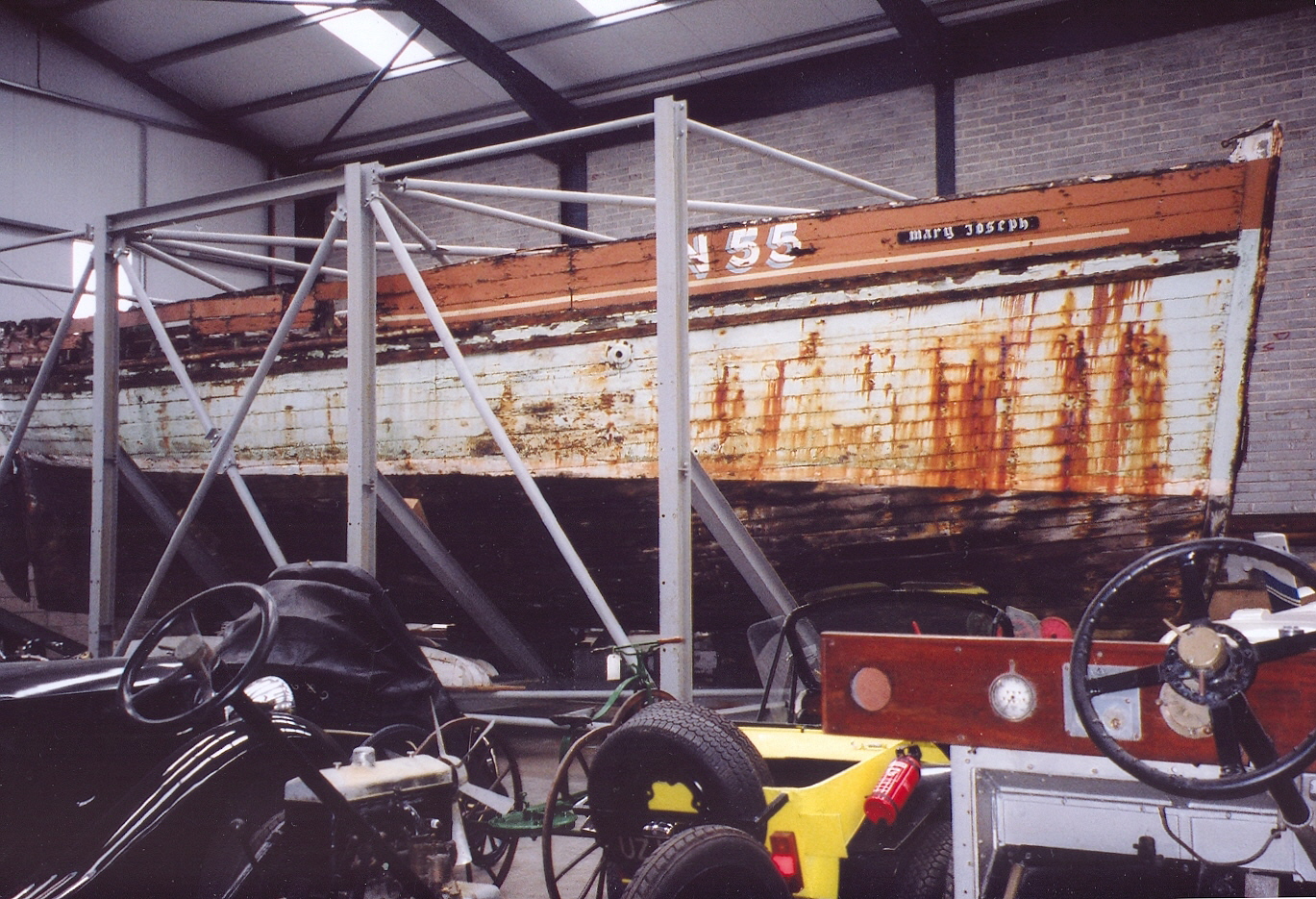Declaration of intent to deconstruct National Historic Fleet vessel Mary Joseph
National Museums NI hereby announces its intention to commence deconstruction of the National Historic Fleet vessel Mary Joseph unless any viable alternative solution is put forward before the deadline of midday on Monday 9 December 2024.
Mary Joseph is a vernacular boat type known as a nickey. These were large carvel-built sailing drifters, or drivers, with lug sails fore and aft, famed for their speed. Built in 1877, and constructed of wooden planks on sawn oak frames, she was registered in Newry (N) and allocated the number 55. She is 15.70 metres in length overall and was motorised in 1920. The boat has regional importance as it was the first fishing vessel in Kilkeel harbour to be equipped for prawn fishing in 1954. The Mary Joseph also has an interesting link to the First World War. On 17 May 1918 the Kilkeel fleet left the harbour to drift net for herring when they were approached by a German U-boat, ordered to evacuate their vessels, five of which were subsequently blown up. Mary Joseph assisted in bringing the men from these boats back to Kilkeel harbour.
Condition of Mary Joseph
Mary Joseph is in an advanced state of decay and, according to a recent survey, the current condition should be regarded as at serious risk.
- The degree and level of structural timber decay and deformation within the hull, decks, keel and framing is severe and now at an increased probability of physical failure.
- Although there appears to be some residual strength within the frame, the superstructure, decks, fixtures and fittings are very fragile and likely to fail.
- There is severe deformation within the keel and stern and rudder posts.
- The rudder is breaking away from the stern post.
- Many original heavy-weight components, such as the two engines and associated gearboxes, transmission and operating systems remain in-situ and these are located in very high-risk compromised areas within the hull and decks.
- The fabricated boat cradle, although sufficient in concept no longer provides adequate, full-length targeted support because of the geometric deficiencies within the original design.
Reasons for Deconstruction
Due to the severe degradation of this vessel, there is a health and safety risk to both staff and objects. The continuing advanced level of deterioration within the hull and framing now requires an uprated cradle design to provide additional support for the vessel to safeguard short/mid-term preservation.
Unfortunately, due to the level of decay, an uprated cradle design which incorporates the required number of interlocking linear shears and circumferential supports will greatly obscure the natural lines of the vessel vastly decreasing the future interpretive value.
The projected costs are over £2m+ to stabilise and restore it to static display condition and are not in proportion to the opportunities for display that can be afforded in the present galleries. Investing such a large amount of money into a project that will continue to remain in storage does not present a viable solution either financially or ethically.
Potential future uses for Mary Joseph
If a suitable and experienced organisation were able to use Mary Joseph, there is the potential for her to be preserved or restored but the transport of her to another location would need to be carefully considered as there is a risk of collapse during the process.
Current location of vessel
Mary Joseph is currently stored in offsite stores at the Titanic Quarter, Belfast. Any expressions of interest will need to demonstrate how she would be moved from this site, what the long-term sustainable plan for her would be and where any stabilisation or repair works would be carried out as it is not possible for these to be undertaken in situ.
Work to date
A maritime survey was carried out in 2021 by Ian Clark Restoration of the entire maritime collection including Mary Joseph outlining the very poor condition and the risks currently posed to staff and surrounding collections.
Online discussions with National Historic Ships UK and other parties such as the National Museum of the Royal Navy and Windemere Jetty Museum have taken place. An online presentation and discussion around the proposed deconstruction of the ship De Wadden from Liverpool Maritime Museum took place in Jan 2024 and has proven invaluable in providing guidance around this type of disposal.
Information and records
Records for this vessel are held by the Ulster Transport Museum, National Museums NI. These include accession and acquisition information, condition surveys and historic research into the story of Mary Joseph which can be made available on request. If deconstruction goes ahead, a formal entry will be created for the ship on the National Archive of Historic Vessels and held, in perpetuity, by National Historic Ships UK.
For further information about this vessel, please view her entry on the National Register of Historic Vessels https://www.nationalhistoricships.org.uk/register/479/mary-joseph which includes a Statement of Significance or see Mary Joseph | National Museums NI for the latest updates from National Museums NI.
Any interested parties wishing to: make an offer for the ship, explore taking a section or related fittings for re-use or display (price on application to reflect works carried out to date); propose a sustainable new end use or location; or provide further documentary and photographic evidence, should contact: Hannah Crowdy at National Museums NI at Hannah.crowdy@nationalmuseumsni.org as soon as possible and no later than 9 December 2024.
What is Deconstruction?
Please download the NHS-UK guidance on Deconstructing Historic Vessels for further details.
 Zone
Northern Ireland
Zone
Northern Ireland
